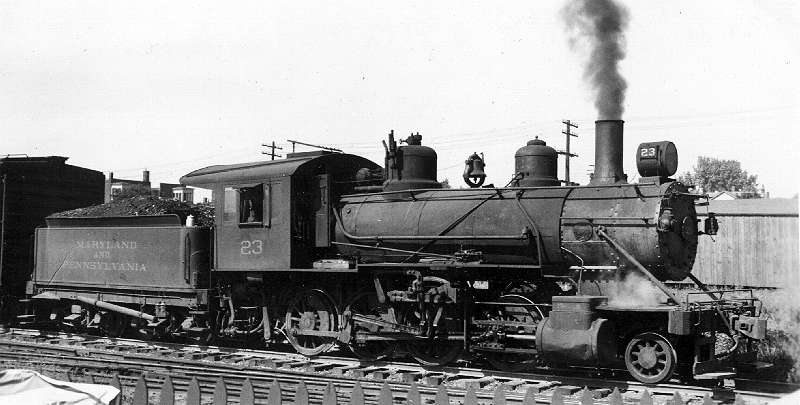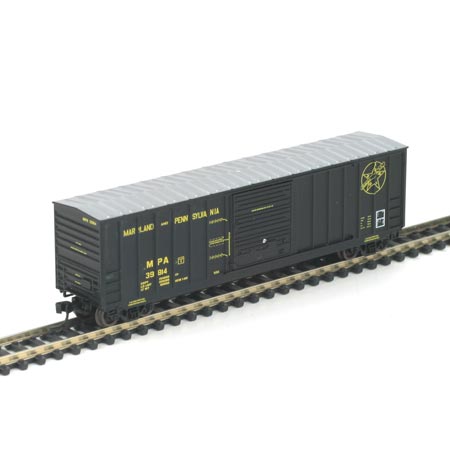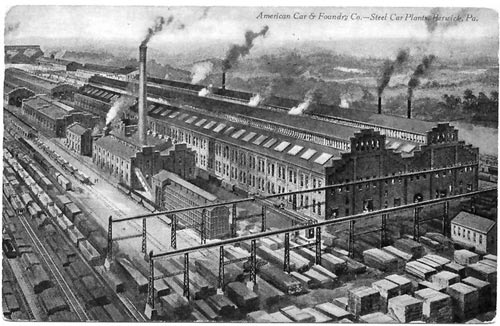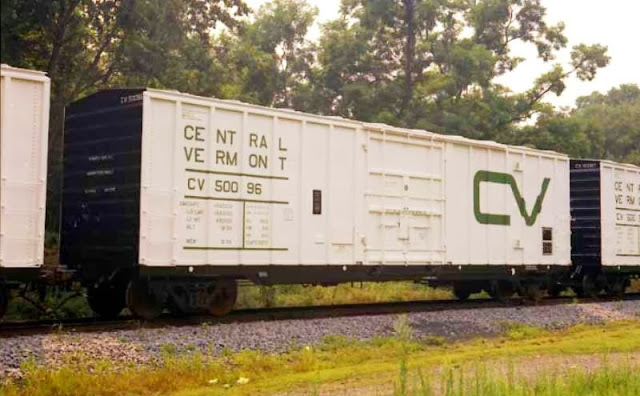Specific Item Information: N RTR 50 foot Berwick Box, MA & PA #39814
Model Information: Boxcar, 50 Foot, Youngstown Single Sliding Door, Rib Side, Without Roofwalk, modeled after a prototype produced by BFF (Berwick Forge and Fabricating). MDC has released this model both in 'kit' and RTR (Read-to-Run) packaging. None of the features on the model actually match the Berwick prototype. Athearn acquired this tooling from MDC in 2004, and has since re-released it more than once. Athearn markets BFF models with both door styles (Pickens and Youngstown) as 'Berwick Boxcars'. The Athearn models feature magnetically operated couplers and are always RTR.
Prototype History: The US government came up with a scheme to create an artificial incentive for railroads to buy new boxcars. If a railroad increased its boxcar fleet it was allowed to charge other railroads (not the customer) more for their daily use. (That's Per Diem). As an example, if the Crab Orchard and Egyptian acquired a fleet of 500 boxcars (up from zero) , and got them loaded on the ICG, it could charge the ICG for their use at an "Incentive Per Piem" rate that more than paid the CO&G's cost of ownership. So new boxcars got pumped into the system while old boxcars sat idle.
To cater to this demand, Berwick introduced its 50-foot boxcar in 1972 and sold the exterior-post car to more than 35 railroads. Though Berwick stopped production in 1982, the boxcars are still commonly seen throughout North America.
To cater to this demand, Berwick introduced its 50-foot boxcar in 1972 and sold the exterior-post car to more than 35 railroads. Though Berwick stopped production in 1982, the boxcars are still commonly seen throughout North America.
Road Name History:  The Ma & Pa (as it was known) was the result of the 1901 merger of two lines together linking Baltimore, Maryland with York, Pennsylvania. Although these cities are just 45 miles apart, it took the Ma & Pa 77 miles of route to connect them. The predecessors had been originally constructed to 3’ gauge so tight curves, light bridges, and thin roadbed were the rule. Both were standard gauged before the Ma & Pa merger. At its peak in 1913, they had 573 employees! The largest steam locomotives were 2-8-0’s and they never owned an engine with a trailing truck. With all of the sharp curves (36% of the mileage was curved track) derailments were relatively common. Ma & Pa was one of very few shortlines to have its own derrick.
The Ma & Pa (as it was known) was the result of the 1901 merger of two lines together linking Baltimore, Maryland with York, Pennsylvania. Although these cities are just 45 miles apart, it took the Ma & Pa 77 miles of route to connect them. The predecessors had been originally constructed to 3’ gauge so tight curves, light bridges, and thin roadbed were the rule. Both were standard gauged before the Ma & Pa merger. At its peak in 1913, they had 573 employees! The largest steam locomotives were 2-8-0’s and they never owned an engine with a trailing truck. With all of the sharp curves (36% of the mileage was curved track) derailments were relatively common. Ma & Pa was one of very few shortlines to have its own derrick.
Think of the Ma & Pa as a Virginia & Truckee of the east. The steam locomotives were antiques, the freight cars were wooden, and the coaches had open platforms decades after other lines had modernized.
Traffic included furniture from Red Lion, slate from Delta, and milk from just about every town along the line. Passenger service was exceedingly slow with the daily York to Baltimore train taking 4 hours to cover the 77 track miles. Passenger service ended in 1953.
In 1958, the lines in Maryland were abandoned. The following year, Ma & Pa relaid track on the Peachbottom branch that had been abandoned and pulled up in 1903. A nuclear power plant was under construction at Peachbottom and the Ma & Pa moved construction material on the line for several years. In 1971, Eamons Industries bought the line as a means of entering the freight car leasing business. Over the next decade, the Ma & Pa freight car fleet swelled to over 2,000 cars (and not a wooden one in the lot.)
In 1976, Ma & Pa picked up the former Pennsylvania Railroad line from York to Walkersville, Maryland although that was cut back to Hanover, Pennsylvania just two years later. That year the original Ma & Pa mainline south of Red Lion was abandoned followed by the rest of original mainline in 1983. At that point, the Ma & Pa was operating exclusively on former PRR lines, whose construction standards were much more stout than Ma & Pa’s narrow gauge predecessors.
Late in 1999, Maryland & Pennsylvania merged with another area shortline called Yorkrail. The new railroad is called York Railway with 42 miles of line serving about 40 customers. They are now part of the Genesee & Wyoming shortline family. A short segment of the original Ma & Pa main has been preserved.

Think of the Ma & Pa as a Virginia & Truckee of the east. The steam locomotives were antiques, the freight cars were wooden, and the coaches had open platforms decades after other lines had modernized.
Traffic included furniture from Red Lion, slate from Delta, and milk from just about every town along the line. Passenger service was exceedingly slow with the daily York to Baltimore train taking 4 hours to cover the 77 track miles. Passenger service ended in 1953.
In 1958, the lines in Maryland were abandoned. The following year, Ma & Pa relaid track on the Peachbottom branch that had been abandoned and pulled up in 1903. A nuclear power plant was under construction at Peachbottom and the Ma & Pa moved construction material on the line for several years. In 1971, Eamons Industries bought the line as a means of entering the freight car leasing business. Over the next decade, the Ma & Pa freight car fleet swelled to over 2,000 cars (and not a wooden one in the lot.)
In 1976, Ma & Pa picked up the former Pennsylvania Railroad line from York to Walkersville, Maryland although that was cut back to Hanover, Pennsylvania just two years later. That year the original Ma & Pa mainline south of Red Lion was abandoned followed by the rest of original mainline in 1983. At that point, the Ma & Pa was operating exclusively on former PRR lines, whose construction standards were much more stout than Ma & Pa’s narrow gauge predecessors.
Late in 1999, Maryland & Pennsylvania merged with another area shortline called Yorkrail. The new railroad is called York Railway with 42 miles of line serving about 40 customers. They are now part of the Genesee & Wyoming shortline family. A short segment of the original Ma & Pa main has been preserved.
Brand/Importer Information: Athearn's history began in 1938, when its founder-to-be, Irvin Athearn, started an elaborate O scale layout in his mother's house. After placing an ad selling the layout, and receiving much response to it, Irv decided that selling model railroads would be a good living. He sold train products out of his mother's house through most of the 1940s. After becoming a full-time retailer in 1946, Irv opened a separate facility in Hawthorne, California in 1948, and that same year he branched into HO scale models for the first time.
Athearn acquired the Globe Models product line and improved upon it, introducing a comprehensive array of locomotive, passenger and freight car models. Improvements included all-wheel drive and electrical contact. One innovation was the "Hi-Fi" drive mechanism, employing small rubber bands to transfer motion from the motor spindle to the axles. Another was the double-ended ring magnet motor, which permitted easy connection to all-wheel-drive assemblies. Athearn was also able to incorporate flywheels into double-ended drives.
The company produced a model of the Boston & Maine P4 class Pacific steam locomotive which incorporated a cast zinc alloy base and thermoplastic resin superstructure. It had a worm drive and all power pickup was through the bipolar trucks that carried the tender. This item was discontinued after the Wilson motor was no longer available, and was not redesigned for a more technologically advanced motor.
Athearn's car fleet included shorter-than-scale interpretations of passenger cars of Southern Pacific and Atchison, Topeka & Santa Fe Railroad prototypes. The company also offered a variety of scale-length freight cars with sprung and equalized trucks. The cars could be obtained in simple kit form, or ready-to-run in windowed display boxes. The comprehensive scope of the product line contributed to the popularity of HO as a model railroad scale, due to the ready availability of items and their low cost.
Irv Athearn died in 1991. New owners took control in 1994, but continued to follow Athearn's commitment to high-quality products at reasonable prices. Athearn was bought in 2004 by Horizon Hobby. Athearn was then moved from its facility in Compton to a new facility in Carson, California. In mid-2009, all remaining US production was moved to China and warehousing moved to parent Horizon Hobby. Sales and product development was relocated to a smaller facility in Long Beach, California.
Read more on Wikipedia and Athearn website.
Athearn acquired the Globe Models product line and improved upon it, introducing a comprehensive array of locomotive, passenger and freight car models. Improvements included all-wheel drive and electrical contact. One innovation was the "Hi-Fi" drive mechanism, employing small rubber bands to transfer motion from the motor spindle to the axles. Another was the double-ended ring magnet motor, which permitted easy connection to all-wheel-drive assemblies. Athearn was also able to incorporate flywheels into double-ended drives.
The company produced a model of the Boston & Maine P4 class Pacific steam locomotive which incorporated a cast zinc alloy base and thermoplastic resin superstructure. It had a worm drive and all power pickup was through the bipolar trucks that carried the tender. This item was discontinued after the Wilson motor was no longer available, and was not redesigned for a more technologically advanced motor.
Athearn's car fleet included shorter-than-scale interpretations of passenger cars of Southern Pacific and Atchison, Topeka & Santa Fe Railroad prototypes. The company also offered a variety of scale-length freight cars with sprung and equalized trucks. The cars could be obtained in simple kit form, or ready-to-run in windowed display boxes. The comprehensive scope of the product line contributed to the popularity of HO as a model railroad scale, due to the ready availability of items and their low cost.
Irv Athearn died in 1991. New owners took control in 1994, but continued to follow Athearn's commitment to high-quality products at reasonable prices. Athearn was bought in 2004 by Horizon Hobby. Athearn was then moved from its facility in Compton to a new facility in Carson, California. In mid-2009, all remaining US production was moved to China and warehousing moved to parent Horizon Hobby. Sales and product development was relocated to a smaller facility in Long Beach, California.
Read more on Wikipedia and Athearn website.
Item created by: George on 2016-09-16 15:09:00. Last edited by gdm on 2018-02-16 09:06:17
If you see errors or missing data in this entry, please feel free to log in and edit it. Anyone with a Gmail account can log in instantly.
If you see errors or missing data in this entry, please feel free to log in and edit it. Anyone with a Gmail account can log in instantly.










